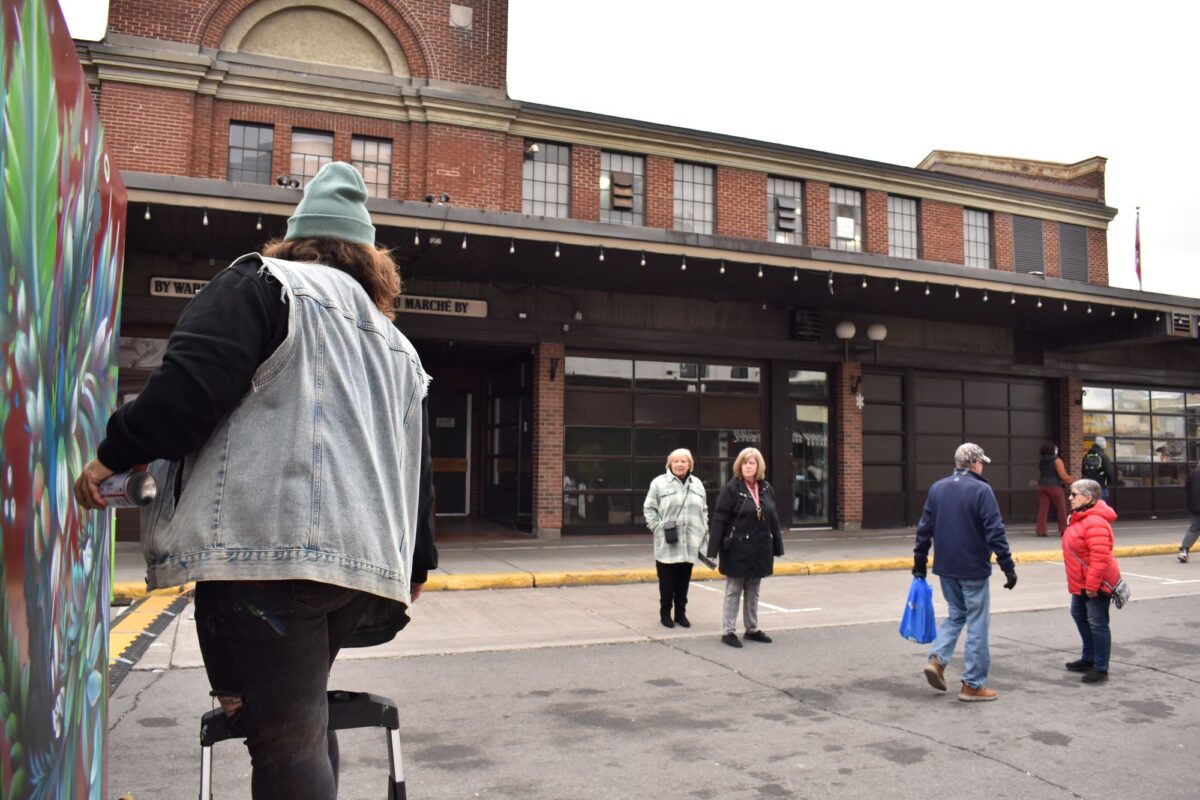On a busy Saturday morning in downtown Ottawa, graffiti artist Mique Michelle is working on a new mural decorating a storage container for the ByWard Market’s new skating rink. As the work takes shape, passersby stop to watch. A teenaged boy says, “Nice painting!” Two middle-aged women admire from afar, then ask how long the process takes.
Michelle says these positive interactions are common when she’s out painting: “I’m a big fan of the process, of being communicative,” she says.
However, Michelle says misconceptions around graffiti art can cause people to assume anyone with a spray can is behaving illegally or harmfully.

Graffiti is considered vandalism by the City of Ottawa when it involves unauthorized writing or drawings on public or private property. However, many artists argue the distinction between graffiti art and vandalism is misunderstood. As an extension of hip-hop culture, graffiti art has historically been a voice of social conscience, Michelle says, referencing the Berlin Wall and Keith Haring’s art during the AIDS crisis.
Michelle says she believes the city conflating graffiti and vandalism places all street artists under a harmful label and makes it more difficult to combat negative stereotypes and gain acceptance for their work as a legitimate cultural and artistic expression.

That concern seems to be reflected in the data.
Capital Current’s analysis of the City of Ottawa’s service requests shows complaints made about graffiti in Somerset Ward have increased. Some 398 complaints were made to the city in Somerset Ward between Jan. 1 and Oct. 31, compared to 159 complaints made over that same time period in 2021.
Of the 398 complaints, 305 were made about graffiti that was neither hateful nor offensive, the data shows.
The City of Ottawa Graffiti Management by-law requires all properties be graffiti-free. Once a complaint has been made, property owners have seven days to remove it. Failure to do so may result in city personnel removing the work and adding cost of removal to the owner’s property taxes.

If the reported graffiti is on the front or sides of a property, the city removes it at no cost to the property owner, says Yukang Li, the executive director of Ottawa Chinatown's Business Improvement Area (BIA). If the graffiti is on the back of the building, the property owner is responsible for removal.
“We have been working with the city's graffiti team, and they are a wonderful team. They patrol our streets almost every day. And as soon as graffiti is spotted, they would dispatch a team and remove the graffiti almost immediately,” says Li.
To prevent graffiti on private property, the city has introduced anti-graffiti programs, such as Paint it Up!, an outdoor mural painting program that gives young people an opportunity to express their creativity on permitted walls.
Ottawa has three legal graffiti walls or “free spaces,” where artists are free to paint whatever they like.
Some business owners in Chinatown find that murals and street art improve business and deter people from tagging their walls. Many of the murals in this Somerset Ward neighbourhood were commissioned by the BIA in cooperation with the Ottawa School of Art for a public art project, "Chinatown Blossoms," in 2013.


Megane Legault works at Birling, a skateboarding shop in Chinatown. She says the building’s mural by artist Five Cents (Julian Garner) draws customers into the shop.
“I feel [graffiti is] definitely self-expression. Skateboarding and art are both tied up with [...] self-expression,” adds Legault.
Legault says the wall is rarely tagged, citing a “respect culture” among artists.
Michelle, who’s been working with youth since 2004 and as a touring artist since 2013 says more legal walls in Ottawa would help promote artistic expression.
Ultimately, graffiti is about access to art and dialogue, says Michelle. “This piece, you don't have to pay anything to come see it,” she says, gesturing at her mural in the Market.
“It's gotta be here, whenever you need it, even if you don't have to have a black tie or a certain bank account. ... I had two people come up who were unhoused, who just wanted to chat. Because you’re in public and you’re not necessarily someone with a badge — you know, you’re tattooed up, you’re covered in paint — it makes it way more accessible. Not with the word ‘therapy’ around it or ‘outreach,’ but just being part of the community.”
She says graffiti art is a powerful medium for communication, especially for marginalized communities.
“Leaving a message on the wall for everyone to see it — no one can say they ‘didn’t know’ when it’s a 40- by 60-foot message you see daily.”




